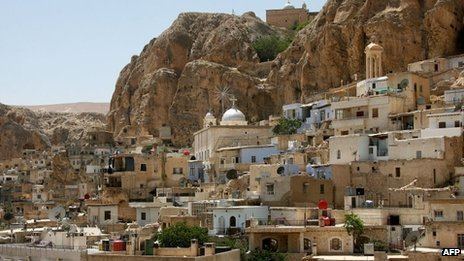Country Syria Nahiyah Ma'loula Local time Thursday 10:26 PM | District Al-Qutayfah District Elevation 1,500 m (4,900 ft) | |
 | ||
Governorate Rif Dimashq Governorate Weather 2°C, Wind SW at 8 km/h, 78% Humidity Neighborhoods El-Bayader, El-Jameiat, Saint Sergios Housing association, The Old Village | ||
Ma'loula, Maaloula, or Ma'lula (Aramaic: ܡܥܠܘܠܐ, Maʿlūlā; Arabic: معلولا Maʿlūlā) is a town in the Rif Dimashq Governorate in Syria. The town is located 56 km to the northeast of Damascus and built into the rugged mountainside, at an altitude of more than 1500 m. It is known as one of three remaining villages where Western Aramaic is still spoken, the other two being the nearby villages Jubb'adin and Al-Sarkha (Bakhah).
Contents
- Map of Maaloula Syria
- Etymology
- Population
- Language
- Monasteries
- Mar Sarkis
- Mar Taqla
- Other monasteries
- War in Syria
- Virgin Mary statue
- Sister city
- References
Map of Maaloula, Syria
Etymology
Maʿlūlā is from the Aramaic word maʿʿəlā (ܡܥܠܐ), meaning 'entrance'. Until recently, the town was dominated by speakers of Western Neo-Aramaic.
Population
According to the Syria Central Bureau of Statistics, Ma'loula had a population of 2,762 in the 2004 census. However, during summer, it increases to about 10,000, due to people coming from Damascus for holidays. Half a century ago, 15,000 people lived in Ma'loula.
Religiously, the population consists of both Christians (mainly members of the Greek Orthodox Church of Antioch and the Melkite Greek Catholic Church) and Muslims. For the Muslim inhabitants, the legacy is all the more remarkable given that they were not Arabised, unlike most other Syrians who like them were Islamised over the centuries but also adopted Arabic and shifted to an Arab ethnic identity.
Language
With two other nearby towns al-Sarkha (Bakhah) (Arabic: بخعة/الصرخه) and Jubb'adin (Arabic: جبّعدين), Ma'loula is the only place where one of the Western Aramaic languages is still spoken, which it has been able to retain amidst the rise of Arabic due to its distance from other major cities and its isolating geological features. However, modern roads and transportation, as well as accessibility to Arabic-language television and print media - and for some time until recently, also - have eroded that linguistic heritage.
As the last remaining places where Western Neo-Aramaic is still spoken, the three villages represent an important source for anthropological linguistic studies regarding first century Western Aramaic. According to scholarly consensus, the language of Jesus was also a Western Aramaic dialect; more specifically the Galilean variety of Jewish Palestinian Aramaic. Despite frequent misstatements in the media, however, the Neo-Aramaic spoken in Ma'loula, Bakhah and Jubb'adin is not identical to the dialect which Jesus of Nazareth spoke, since it underwent significant changes since the first century AD.
Monasteries
There are two important monasteries in Ma'loula: the Eastern Catholic Mar Sarkis and Greek Orthodox Mar Thecla.
Mar Sarkis
One of the oldest surviving monasteries in Syria. It was built on the site of a pagan temple, and has elements which go back to the fifth to sixth century Byzantine period. Mar Sarkis is the Assyrian name for Saint Sergius, a Roman soldier who was executed for his Christian beliefs. This monastery still maintains its solemn historical character.
Mar Sarkis has two of the oldest icons in the world, one depicting the Last Supper.
Mar Taqla
This monastery holds the remains of Thecla, which the second-century Acts of Paul and Thecla accounts a noble virgin and pupil of St. Paul. According to later legend not in the Acts, Taqla was being pursued by soldiers of her father to capture her because of her Christian faith. She came upon a mountain, and after praying, the mountain split open and let her escape through. The town gets its name from this gap or entrance in the mountain. However, there are many variations to this story among the residents of Ma'loula.
Other monasteries
There are also the remains of numerous monasteries, convents, churches, shrines and sanctuaries. There are some that lie in ruins, while others continue to stand, defying age. Many pilgrims come to Ma'loula, both Muslim and Christian, and they go there to gain blessings and make offerings.
War in Syria
Ma'loula became the scene of battle between Al-Qaeda linked jihadist Al-Nusra Front and the Syrian Army in September 2013.
Syrian rebels took over the town on October 21. Around 13 people were killed, with many more wounded.
On October 28, government forces recaptured the town.
Ma'loula was taken over by al-Nusra Front, opposing the Syrian government, again on December 3, 2013. The Front took 12 orthodox nuns as hostages. The nuns were moved between different locations and ended up in Yabroud where they stayed for three months. Then, officials from Qatar and Lebanon negotiated a deal for their release. Those negotiations produced an agreement on a prisoner exchange under which around 150 Syrian women detained by the government were also freed. After the nuns were freed on the 9th of March 2014, they stated that they were treated well by their captors.
On 14 April 2014, with the help of Hezbollah and SSNP, the Syrian Army once more took control of Ma'loula. This government success was part of a string of other successes in the strategic Qalamoun region, including the seizure of the former rebel bastion of Yabroud in the previous month.
Virgin Mary statue
The people of Ma'loula celebrated as a new statue of the Virgin Mary was erected in its centre, replacing the figure destroyed in rebel attacks in 2013. On 13 June 2015, Syrian officials unveiled the new statue of the Virgin Mary, draped in a white robe topped with a blue shawl, her hands lifted in prayer. The fiberglass figure stood at just over 3 metres (10 feet) tall and was placed on the base of the original statue.
The statue is titled as Lady of peace (Arabic: سيدة السلام).
